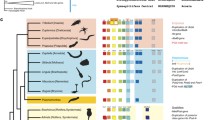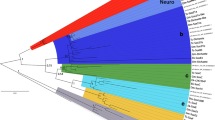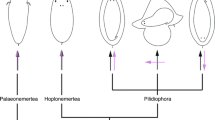Abstract
We have cloned, from an oribatid mite, a gene homologous to the zerknült (zen) genes of insects and the Hox 3 genes of vertebrates. Hox genes specify cell fates in specific regions of the body in all metazoans studied and are expressed in antero-posteriorly restricted regions of the embryo. This is true of the vertebrate Hox 3 but not of the zen genes, the insect homologs, and it has been proposed that the zen genes have lost their Hox-like function in the ancestor of the insects. We studied expression of a mite Hox 3/zen homolog and found that it is expressed in a discrete antero-posterior region of the body with an anterior boundary coinciding with that of the chelicerate homolog of the Drosophila Hox gene, proboscipedia, and propose that its loss of Hox function in insects is due to functional redundancy due to this overlap with another Hox gene.
Similar content being viewed by others
Author information
Authors and Affiliations
Additional information
Received: 23 April 1998 / Accepted: 25 August 1998
Rights and permissions
About this article
Cite this article
Telford, M., Thomas, R. Of mites and zen: expression studies in a chelicerate arthropod confirm zen is a divergent Hox gene. Dev Gene Evol 208, 591–594 (1998). https://doi.org/10.1007/s004270050219
Issue Date:
DOI: https://doi.org/10.1007/s004270050219




